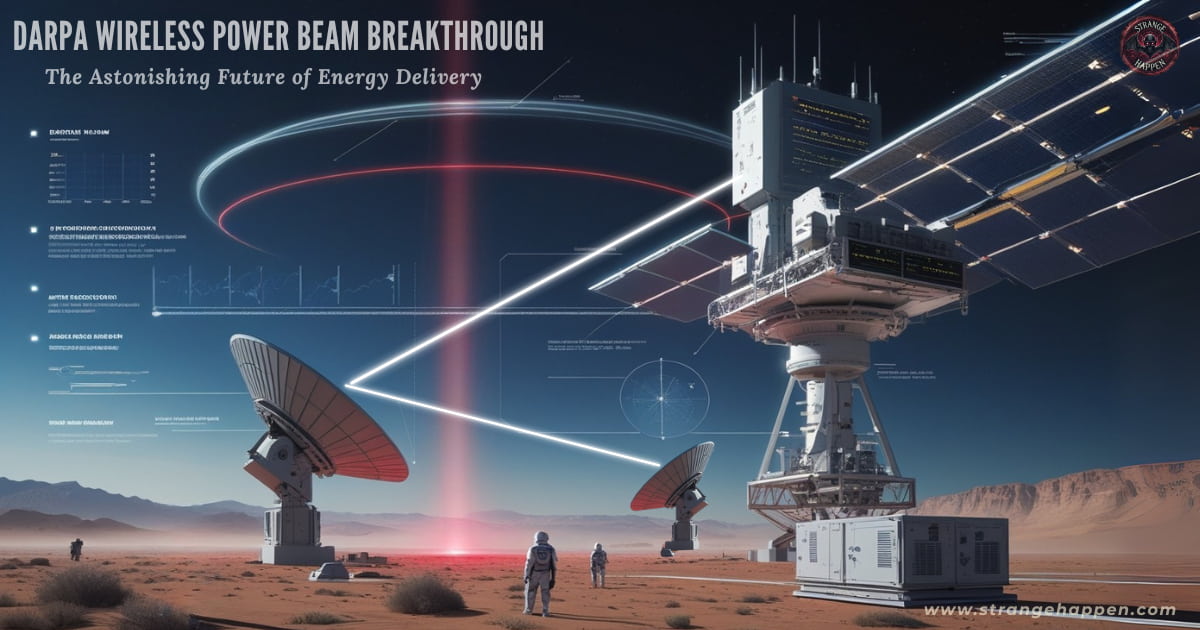DARPA Wireless Power Beam: The Shocking Future of Energy

In today’s fast-evolving world, the demand for faster, cleaner energy is reaching new heights. And stepping boldly into this space is the DARPA wireless power beam—a groundbreaking technology that could soon change how we power everything from cities to battlefields. Developed by DARPA, the U.S. military’s advanced research agency, this project challenges the very way we think about electricity. No wires. No grids. Just high-powered beams of energy—delivered invisibly through air.
It sounds like a sci-fi fantasy, right? But this is no fiction. The DARPA wireless power beam uses directed-energy lasers to transmit power over long distances—even potentially from space. These strange happenings, once the stuff of speculation, are now becoming real and measurable. And the implications could be enormous.
Could we be on the brink of a future where disaster zones, military outposts, or entire regions receive electricity without a single physical connection? Every successful DARPA test brings us one step closer to making this vision a global reality.
Table of Contents
The DARPA Wireless Power Beam: What Is It?
At the heart of this innovation lies the DARPA wireless power beam—a bold step forward in how energy is created, transmitted, and consumed. Instead of relying on traditional power lines or fuel deliveries, DARPA’s system uses powerful lasers to send electricity across open distances. It’s part of a larger effort to enable space-based wireless electricity, where solar stations in orbit beam energy straight down to receivers on Earth.
So what makes this different from earlier attempts? Precision. Purpose. And potential. Originally designed to support cutting-edge U.S. military energy technology, the project also holds huge promise for humanitarian and commercial use.
How It Works: A Glimpse Into Directed-Energy Transmission
While the idea may sound complex, the core mechanism is surprisingly straightforward. Electricity is first converted into a focused laser beam—usually in the infrared spectrum. This beam travels through the air and is captured by special photovoltaic receivers, which convert it back into usable electricity on the ground.
Key components include:
- Adaptive optics to ensure the beam stays stable over long distances.
- Infrared lasers optimized for minimal atmospheric disruption.
- Custom-built photovoltaic receivers that maximize power conversion.
These strange happenings are not just theoretical—they are being engineered with astonishing precision and tested in real-world conditions.
Benefits of Laser Energy Beaming
What makes this technology such a game-changer? The potential applications of beaming energy through lasers are enormous:
- Instant Energy Access—Send power to remote areas on demand.
- Fuel-Free Warfare—Cut the risks of fuel supply convoys in combat zones.
- Environmentally Friendly – Reduce emissions and infrastructure waste.
- No Grid Needed—Ideal for off-grid or post-disaster scenarios.
- Global Reach—A long-term solution for universal energy access.
As highlighted by Strangehappen.com, these strange happenings could redefine the entire energy landscape.
The Real Risks: What Could Go Wrong?
Of course, every innovation carries its risks—and beaming energy through laser is no exception:
- Weather Interference—Rain, fog, and dust can disrupt transmission.
- Safety Concerns—High-powered lasers may pose hazards to living beings.
- Energy Loss—Despite being focused, some energy is inevitably lost over distance.
- Technical Complexity—High-precision systems require flawless execution.
- Weaponization Risk—As with all directed-energy systems, misuse is a concern.
DARPA continues to prioritize safety in its designs. But as with all strange happenings, the full range of implications will unfold over time.
How Much Will It Cost?
Developing the DARPA wireless power beam involves major investment and risk but promises immense future rewards. Compared to the recurring costs of traditional fuel logistics, wireless energy transmission may ultimately prove far more efficient.
Here’s a breakdown of estimated costs:
- Prototype Development – ~$45 million.
- Testing Infrastructure—$10–15 million.
- Field Trials & Deployment – $5–15 million.
- Total Estimate: $60–75 million.
The initial investment may seem steep, but over time, the strategic and economic benefits could far outweigh the costs. These strange happenings might very well be tomorrow’s financial advantage.
The Technology: What Type of Energy Is Used?
This system is based on directed-energy transmission—a process in which electricity is converted into light, beamed across open air, and then turned back into power at its destination.
Key technological elements include:
- Wavelength control for precision in various weather conditions.
- Heat regulation to prevent system overload.
- Real-time targeting systems to keep beams on track even when the receiver is mobile.
These innovations ensure stability and effectiveness, even in complex environments.
A Brief History: When Did It All Begin?
The idea of sending electricity without wires isn’t new—visionaries like Nikola Tesla were already chasing it more than a hundred years ago. Today, what once seemed like a wild dream is being revived with lasers and satellites. But the modern DARPA wireless power beam effort started gaining serious ground in the last few years.
Timeline Snapshot:
- 2019–2021 – Concept modeling, safety evaluations.
- 2022 – First successful lab trial.
- 2023–2024 – Real-world field testing, including a 5.3-mile energy beam demonstration.
Strange Happenings has reported closely on this evolution, documenting how imagination is slowly becoming implementation.
When Will It Be Completed?
While timelines are fluid, DARPA has laid out a general roadmap for the wireless power beam project:
- 2025–2027—More field testing, including potential space-to-ground applications.
- 2028–2030—Integration into military systems, from mobile bases to aerial drones.
- Post-2030—Expansion into humanitarian relief, disaster response, and public infrastructure.
These strange happenings might be early signals of a much larger transformation just ahead.
Which Countries Are Implementing This Technology?
The concept of space-based wireless electricity is gaining traction beyond the United States. Several countries have begun investing in or testing similar directed-energy systems:
- United States (DARPA)
Leader in military-grade power beam development; conducted real-world tests up to 5.3 miles - China
Investing in space-based solar power (SBSP) for orbital energy transmission; exploring high-altitude laser beaming - Japan
JAXA-led initiatives for beaming solar power from space stations; early adopter of microwave-based energy systems - South Korea
Civil-military R&D focused on airborne energy transmission for communication infrastructure - European Union (Germany & France)
Research consortiums studying laser and microwave energy beaming for green infrastructure solutions
These strange happenings hint at a silent yet intense global push to dominate the future of energy transmission.
Breaking Down the Strange Happenings: A Real-World Test
One of the most eye-opening moments so far came during a demonstration at the Naval Surface Warfare Center, where DARPA successfully transmitted energy across 5.3 miles using their wireless beam system.
What they achieved:
- Uninterrupted Transmission—Stable delivery even under variable conditions
- Pinpoint Accuracy – The beam stayed locked on its target receiver
- Proof of Concept—Real-world feasibility confirmed outside the lab
Once theoretical, these strange happenings are now concrete proof of what’s possible.
Is This the Future of Energy?
If successful on a larger scale, space-based wireless electricity could supply power globally—from orbiting solar stations to ground receivers. It could eliminate the need for traditional grids and power lines altogether.
Consider what this could mean:
- Villages in remote areas powered overnight
- Emergency zones lit up instantly
- Military bases free from fuel delivery risks
The strange happenings we’re seeing today may be laying the groundwork for a completely reimagined energy future.
Final Thoughts: Welcome to the Power Grid of Tomorrow
The journey from Tesla’s wire-free dreams to DARPA’s laser-driven tests has been long, strange, and undeniably exciting. Now, with field-tested systems and growing interest from defense and civilian sectors, we may be nearing the tipping point.
The DARPA wireless power beam reflects more than just scientific ambition—it represents a possible leap in how humanity powers its world. While many challenges remain, the possibilities are too important to ignore. Just like the 1930s Soviet Union Electromagnetic Fast Travel Framework, this too could be another overlooked chapter in humanity’s technological evolution.
As we stand on the edge of this bold frontier, one thing is certain: the invisible power lines of tomorrow may already be lighting the way—much like the unexplained energy anomalies reported around the Alaska Triangle and other mysterious regions where science meets the unknown.
Author: Mubashir Razzaq
Founder of Strange Happenings, paranormal explorer, and researcher of hidden histories and mysterious phenomena. Mubashir dives deep into forgotten places, unexplained legends, and strange happenings across the world—bringing readers stories where history and mystery collide.




